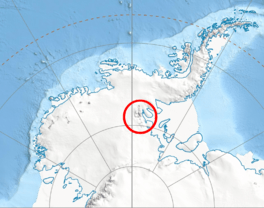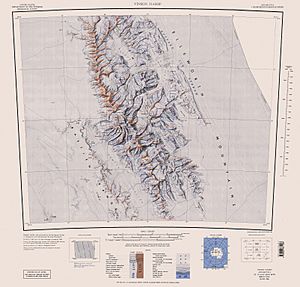Nimitz Glacier facts for kids
Quick facts for kids Nimitz Glacier |
|
|---|---|

Location of Ellsworth Mountains in Western Antarctica
|
|
| Type | tributary |
| Location | Ellsworth Land |
| Coordinates | 78°55′00″S 85°10′00″W / 78.91667°S 85.16667°W |
| Length | 40 nautical miles (74 km; 46 mi) |
| Width | 5 nautical miles (9.3 km; 5.8 mi) |
| Thickness | unknown |
| Terminus | Minnesota Glacier |
| Status | unknown |
The Nimitz Glacier is a very large glacier located in Antarctica. It stretches for about 40 nautical miles (74 km; 46 mi) (that's about 74 kilometers or 46 miles!) and is 5 nautical miles (9.3 km; 5.8 mi) (about 9 kilometers or 6 miles) wide. This massive ice river drains, or flows, from an area about 10 nautical miles (19 km; 12 mi) (19 kilometers or 12 miles) west of the huge Vinson Massif.
The glacier flows towards the southeast, moving between two mountain ranges: the Sentinel Range and the Bastien Range. Eventually, it joins another large glacier called the Minnesota Glacier. All of this happens in the central part of the Ellsworth Mountains.
How Was Nimitz Glacier Discovered and Named?
The Nimitz Glacier was first seen and photographed by a special unit of the United States Navy called Squadron VX-6. They took these important photos during flights on December 14 and 15, 1959. After these flights, the United States Geological Survey used the pictures to create detailed maps of the area.
The glacier was given its name by the Advisory Committee on Antarctic Names (US-ACAN). They chose to name it after Fleet Admiral Chester W. Nimitz. He was a very important leader in the U.S. Navy.
Admiral Nimitz was the Chief of Naval Operations during a huge Antarctic trip called Operation Highjump, which took place in 1947–1948. This expedition was incredibly large and complex for its time. Admiral Nimitz played a key role in making sure this amazing journey to Antarctica could happen. Naming the glacier after him was a way to honor his important contributions.
What Are Tributary Glaciers?
Just like a big river has smaller rivers flowing into it, a large glacier can have smaller glaciers that feed into it. These smaller glaciers are called "tributary glaciers." They add more ice and snow to the main glacier, helping it grow and flow.
Here are some of the tributary glaciers that flow into the Nimitz Glacier:
- Karasura Glacier
- Branscomb Glacier
- Cairns Glacier
- Tulaczyk Glacier
- Zapol Glacier
- Donnellan Glacier
- Gildea Glacier
- Bender Glacier
- Sirma Glacier
Maps of the Area
Scientists and explorers often create detailed maps to understand places like the Nimitz Glacier. These maps help us see the shape of the land, the mountains, and how the glaciers flow.
One important map of this region is:
- D. Gildea and C. Rada. Vinson Massif and the Sentinel Range. Scale 1:50 000 topographic map. Omega Foundation, 2007.



